

Gateways to Wonderland
Gardiner, Montana
Copyright 2020 by Robert V. Goss. All rights reserved. No part of this work may be reproduced or utilized in any form by any means, electronic or mechanical, including photocopying, recording or by an information storage and retrieval system without permission in writing from the author.

Main street of Gardiner, Montana, 1888. Among the earliest photos of Gardiner. Most of the town burned down the following August.
Photo by H.W. Lloyd. This probably Harry W. Lloyd, of the Lloyd & McPherson Saloon. He also served as freighter and notary. He passed in 1957. [Photo courtesy YNP Archives #1397]
The Early Days . . . .
Gardiner was the 1st gateway community of Yellowstone Park, located at the north entrance of the park at the junction of the Yellowstone and Gardiner rivers. Due to the relatively low elevation (about a mile high) and the presence of the Yellowstone River, easy year-round access was available. All of the other current entrances are snow-bound a good portion of the year. The area was traversed by Native Americans for at least 13,000 years and evidence of their presence has been well-documented along the Yellowstone River and other tributaries. The Yellowstone was also a favorite route of the fur trappers and early expeditions into the park. The Gardiner valley was visited by white men as early as 1829, when Joe Meek and other trappers were attacked by Indians near Cinnabar Mountain. In the 1830s mountain man Johnson Gardner trapped in Yellowstone, particularly around the Indian Creek/Gardner River area, known as Gardner’s Hole. The river and town were named after Gardner and somewhere along the line an “i” slipped into the spelling of the town’s name.
In the 1860 prospectors such as George Huston, Jack Baronette, A. Bart Henderson, and Adam Horn Miller traveled along the Yellowstone River into the park searching for the elusive wealth of gold. Discoveries were made along Bear Creek and Jardine and in the northeast portions of the park around the current Cooke City area. Between 1869 and 1871 the expeditions of Folsom –Cook-Peterson, Washburn, Barlow Heap, and F.V. Hayden traversed along the Yellowstone River and through the Gardiner Valley into the depths of the park and began to bring the wonders of Yellowstone into the public eye.

Mountain man Joe Meek, the first known Euro-American to explore the area around Gardiner in 1829.

James McCartney is believed to be the rider at left, with President Roosevelt (center) and Acting Supt. John Pitcher in April 1903. [Courtesy Yellowstone Gateway Museum]
James McCartney and Harry Horr, homesteaded 160 acres at Mammoth and built the first crude log hotel at Mammoth in 1871. McCartney’s status in the park and his relations with the authorities were unstable at best and he was encouraged to leave the park on an involuntary basis on claims he was trespassing, and his land and buildings taken from him. McCartney eventually settled along the northern park boundary and Gardner River around 1879 in the area that would become the town of Gardiner. He was the town’s first postmaster in 1880, founded the fledgling town, and later became unofficial ‘Mayor’. He was the man who introduced President Roosevelt at the dedication ceremonies of the new Roosevelt Arch in 1903. It has been said that he laid out the town along the park border to get back at the government for kicking him out of Mammoth and negating his claims. The park boundary line still runs right along the sidewalk of most of Park Street.
The Town Grows Up (and out) . . . .
In 1883 the NPRR extended their tracks from Livingston MT to Cinnabar, about 3 miles north of town. Anticipating that the line would end up in Gardiner, the community quickly grew. By June of 1883 the town boasted of a population close to 200, consisting mostly of tents, log shacks and 21 saloons, 6 restaurants, 5 general stores, 2 hardware stores and several other types of businesses (and no doubt a few brothels). However, a land dispute between the railroad and 'Buckskin Jim' Cutler prevented the rail line from coming all the way into Gardiner, and the town's growth spurt stopped. L.A. VanHome and Harris Doble discovered the marble and travertine cliffs above town in 1887, but they were not fully developed until the early 1930’s by the NW Improvement Co.
Visitors in 1883 traveled up the Yellowstone Valley to Gardiner and made these comments about the fledgling town . . .
"We soon leave the Yellowstone River and are in the Gardiner River Valley. We stop for a moment at Gardiner City, a town of perhaps 100 log shanties and tents, where most anything can be had. The majority of establishments are, of course, saloons. Curious signs are here used to entice the unsuspecting traveler to stop within. I was lured into a grog shop by the ambiguous announcement In big letters over the door of “Health Office."
Another article claimed that Dr. Tippie's Health Office, "is not as might be supposed from the name, entirely devoted to ameliorating the physical ills of mankind, though so far as dispensing invigorating liquors and soothing cigars, [it] may have that effect.

In 1885 the town’s first public school was established in a small log cabin and the following year the townsite was formally platted by George H. Robinson. On Aug. 31, 1889, a mere three years later most of the town was destroyed by fire, including 19 businesses and 13 homes. It was a terrible loss and setback for the village, but the hardy and resolute residents, did not let the calamity stop the town’s progress. Only a week after the fire the Livingston Enterprise reported many of the citizens were coming to Livingston to acquire loans and building materials. Two weeks after the fire it was reported of Gardiner, “Times are quite lively here now. Buildings are being erected by R. T. Smith, Tom Foley, Joseph Daily, Chris Nuston, Charley Cowel, and in fact all are getting ready to build. It was a great hardship on all the sufferers by the late fire, but they will live through it and the town will be rebuilt.” The schoolhouse, S.M. Fitzgerald's Hotel, some of J.C. McCartney's buildings and a few other structures survived.
[“The Great Gardiner Inferno of 1889,” by R.V. Goss, Montana Pioneer, May 2020]

Left: Photo of Gardiner, Aug. 18, 1889. Probably the last photo taken of the town just two weeks before the Great Fire of 1889.
[Sibley Watson Digital Archive, Univ. of Rochester, NY}
Top: The town of Gardiner in 1890, a year after the fire. The Pratt & Hall Store is front and center. C.B. Scott's Saloon & Billiards and the Gardiner Hotel are to the middle right. Ranger Tavern is far left, with a Restaurant & Bakery to its right. [Photo YNP #33307]
The year 1893 saw the first bridge constructed across the Yellowstone River, about a half-mile downriver from the current bridge, creating incentive for development on the north side of the river. L.H. Van Dyck and J.H. Deever were arranging for the opening of a meat market and butcher shop in Gardiner, and John Spiker set up a water wheel near the Yellowstone River that would pipe water up to the town using the pressure from the river. Water had previously been hauled up in barrels. Two years later he installed a 75-lite Jenny Dynamo at his water plant and was able to put in electric lights at his hotel. By 1902 the land dispute with Cutler had been resolved and the rail tracks were extended into Gardiner that year, creating a prosperity boom for the town. That same year the newspaper Wonderland was first printed in town but only lasted until sometime in 1905. It is available online and can provide a wealth of information about those early days.
First bridge over the Yellowstone in Gardiner in July 1902. It appears little development had taken place on the other side of the river. It did, however, provide good access to the mines at Jardine and Cooke City.
[Photo courtesy George Eastman Museum, Rochester, NY]
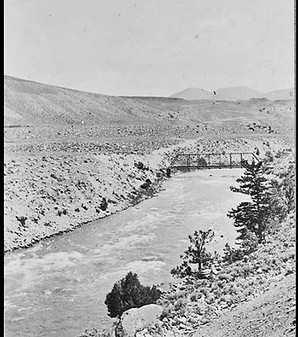

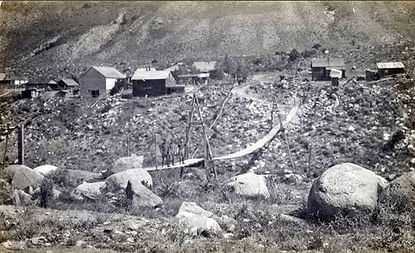
Swinging suspension bridge over the Yellowstone River in Gardiner. Built in 1914, it was located near where the current bridge was constructed in 1930, replacing the old thilling walk above the raging river.
A young woman traveling in 1915 described her trek over the bridge: "The following morning we walk over the village, and one interesting place we visit is an extension bridge over the Gardiner river. It is built for pedestrians and is said to hold up to four people, but wait until you walk out to the center, where the bridge swings up and down with each step, while the rushing, foaming water beneath roars until you do not know whether you are going up or down; then you think it will not hold one."
[Above Left: Photo courtesy Jeanie LaCombe Gregorich] Above Right: 1918 Photo courtesy YNP, Everett Judson Collection]
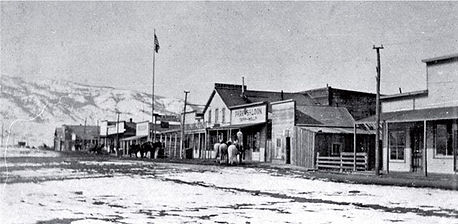
Left: Photo of Gardiner in 1896. C.B. Scott's Saloon & Billiards, along with the Gardiner Hotel are plainly visible to the right. [Burton Holmes Travelogues, 1908]
Right: The town of Gardiner in 1902. the Gardiner Hotel is center, with Tripp & Melloy's Park Saloon to its right, and C.B. Scott's establishment to its left.
[Photo YNP #9130]
Excerpt From a Newspaper Account of a Tourist's Travel to Yellowstone in Early 1883
"To a Land of Wonders - A Yellowstone Park Expedition SIx Years Ago"
(Brooklyn Daily Eagle, Oct. 27, 1889)
"Pushing up against the very boundaries of the reservation there is a veritable Shantyville, Gardiner City, an ideal squatter town, with the rudest houses made of unseasoned boards, with not a few tents mingling with the more pretentious huts, huddled together as though the land was valued by the foot and inch. We took the census of the city and found that of the thirty-two houses which made the settlement, twenty-eight were saloons, the other four being the inevitable bakers' and butchers' shops with a private bar attachment, although not wholly given to the local industry. The town had been built in expectation of being the railway terminus, but there were strange hints that the rails would end at Yankee Jim's, some miles below, and the enterprising squatters were trying to unload their real estate on such guiless tourists as came along. The mining boom was being worked, for a little yellow dust had been found in the prospector's pans; the entire region already was staked out in miners' claims, and in vision the citizens were possessed of millions."
The Northern Pacific RR Comes to Town . . .
The first train arrived in Gardiner on June 20, 1902. Since there was no turn-around yet, the train had to backup to Cinnabar until the following year. The Missoulian newspaper touted on June 26, 1902 that,
“The grading of the Park branch extension was completed to Gardiner Saturday [June 21]. A temporary platform is being erected by the Northern Pacific at Gardiner and the first passenger train reached there Wednesday morning. After this date tourists to and
from the Yellowstone park will board the cars at Gardiner instead of Cinnabar and will avoid an uninteresting four-mile stage drive over a bad road. The people of Gardiner will not celebrate the advent of the iron horse to that place until July 4, when they promise to do things up in great style.”

Construction of the Gardiner Northern Pacific RR depot during the winter of 1902-03. [YNP #161764]
In similar fashion, the Gardiner Wonderland newspaper reported on July 3rd that,
“For the first time the regular passenger train on the Park branch ran into Gardiner and unloaded its passengers at the temporary depot and platform erected in the western part of town. Many of our citizens went down to greet the train and witness the fruition of their long deferred hopes. It may be now said that Gardiner in the terminus, although it will be some little time before freight, other than car lots, will be unloaded here. It is understood to be the intention to erect both a passenger and freight depot."
Robert Reamer, architect of the Old Faithful Inn, designed the building and the firm of Deeks & Deeks was awarded the $20,000 construction contract on April 27, 1903.

Above: View of depot, arch, and W.A. Hall store ca1905.
[F.J. Haynes Postcard No. 183.]

Above: Interior of the Gardiner Depot ca1905.
[From original negative, author's collection.
No reproduction without permission!]
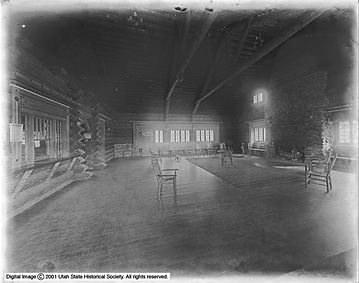
Left: Interior of the Gardiner Depot in August of 1911.
[Courtesy Utah Historical Soc, SHipler Collection]
Right: Interior of the depot, ca1908.
[Campbell's Guide, 1909]
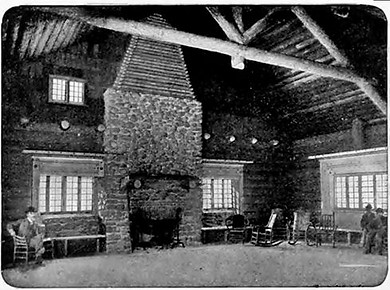
From the Railroad Gazette, April 29, 1904:
"The grounds about, and in the rear of the station are nicely parked, there being within the highway loop a lake, lawns and shrubbery. The arch at the park entrance was designed and built by Major H. M. Chittenden, U. S. Engineers . . . and with its massive lines, rough finish and graceful design, is especially attractive. The corner stone of this arch was laid by President Roosevelt at the time of his trip through the park about a year ago. From each side of the arch there extends a stone wall of the same design and material, the one on the western side continuing around the loop to a point near the platform.
The station at Gardiner was designed to harmonize with the other structures [Yellowstone]. It is essentially rustic and is built of native materials. The foundations and lower parts of the walls are rough boulders. The walls above, including the platform shelters are made of unbarked logs. The roof trusses, gables and ceilings are finished with similar material. The interior contains a large waiting room with fireplace, ticket office, express office, baggage room and toilet rooms. The rustic effect is also carried out in the interior, the doors, windows, settees, chandeliers, hardware, etc., all being in keeping with the general design. The projecting ends of logs are smoothed and polished, and where lumber is used for finishing it is of high grade and finely polished. Wrought nails, bearing on their heads the trade-mark of the company, are used wherever they will show. The fireplace at the end of the waiting room is broad and forms a pleasing feature of the interior."

Above: Train at the depot preparing to unload freight & passengers, ca1905.
[Glass slide, author digital collection]

Above: View of depot and stages leaving for Yellowstone Park. Real-Photo postcard.

Above: View of depot and carriage, 1909.
[Photo from Archibald family collection]
President Theodore Roosevelt’s Visit . . . .
In 1903, President Theodore Roosevelt engaged on a grand western tour, taking him to Chicago, north through Wisconsin, Minnesota and North Dakota. Roosevelt and his companion, famed naturalist writer John Burroughs, arrived at Gardiner, Montana by train on April 8, 1903. The two men were greeted by their host, acting-superintendent Major John Pitcher. The President, Mr. Burroughs, guide “Uncle Billy” Hofer, and an Army escort toured the park for several weeks. Upon their return, Roosevelt dedicated the stone arch that was being built at the entrance of Yellowstone Park.
“Livingston. April 24.—Under a clear sky, surrounded by snow-covered mountain points that give grandeur and beauty to the National park and vicinity, tho cornerstone of the magnificent stone arch now being constructed by the government at the gateway to the nation’s pleasure ground was laid amid pomp and splendor this afternoon. It was a national event and one In which the chief executive of the nation participated. The reception tendered the president and the exercises were a complete success from the reception until the last note of the band died away in the recesses of the adjacent mountains. Tlte weather was all that could be asked for and the day throughout was one that would insure success to the undertaking.”
[25Apr1903, Helena Independent Record]
Above: Dedication ceremonies for the Roosevelt Arch, 24Jul1903.
Arch is to the left with the town of Gardiner in the background.
Roosevelt Arch . . . .
The Arch was built out of native stone in view of the new NPRy depot. Hiram Chittenden came up with the idea, and Robert Reamer designed the Arch It was dedicated by President Theodore Roosevelt on April 24, 1903 and by September visitors were able to drive through the Arch via stagecoach to enter the park. Around 1904 a wire fence was built from the Arch north along the boundary as an attempt to protect antelope from being shot by local hunters. The field between the Arch and the Yellowstone Park Transportation buildings was used as a hayfield for elk feeding for many years. A stone gatehouse was built near the Arch in 1921 and used as a check-in station until it was razed in 1966. The Arch is also known as the North Entrance Arch.
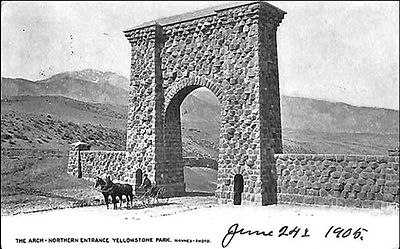
Dedication of Roosevelt Arch, from the Independent Record, Helena, April 25, 1903:
The upper Yellowstone valley never looked better than on this occasion. The residents assisted largely in making the affair a success. They turned out en masse and gave a hearty welcome to the hundreds of visitors that thronged their doors. Gardiner, the gateway to the park, was bedecked in national colors in honor of the occasion. Flags and bunting were everywhere and with the martial music and soldiers from Fort Yellowstone the place took on a military appearance. It was a gala day. The miner, the prospector, the ranchman, all were there and lent valuable aid In making the event Interesting and appropriate. Hundreds of Montana's people were present to greet the president on his return from his visit into the wilds of the park, and to participate in the exercises incident to the laying of the cornerstone.
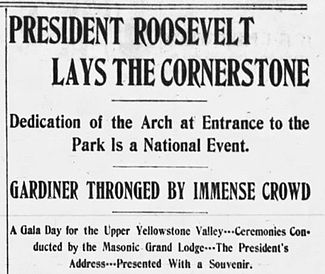

Left: Headline for the dedication ceremony from the Helena Independent Record, 25Jul1903
Right: Construction of the arch, 1902. [YNP #37257]
A bit of culture squeezes in amongst the legion of bawdy bar-rooms

Top Left: 1st schoolhouse in Gardiner, built in 1885 of logs. It was lucky to survive the ravages of the 1889 fire.
[Courtesy Yellowstone Gateway Museum]
Top Right: The 2nd school built at the east end of Park St. around 1904. constructed of native stone. [Real-Photo postcard]
Bottom Right: Around 1915, a 2nd story was added to the 1904 schoolhouse, primarily due to the finances and work of Larry Link and Frank Holem. They postponed payment for their services until the school district could afford it. A new school was built in the area below the Arch in 1951.
[Courtesy Yellowstone Gateway Museum]

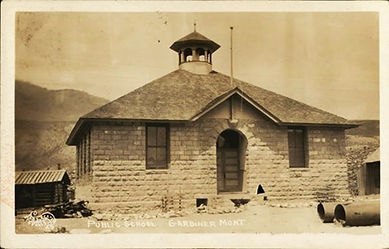

Left: Gardiner Union Church was built in 1904-05 as a community church for the benefit of all residents. Fundraising and construction of the building was spearheaded by WA Hall, CB Scott, LH Link, F. Holem. A committee was formed to raise funds, using dinners, bazaars, horse races, games of chance, and other activities. Harry Child of the YPTCo donated the land for the church. Most everyone in town either gave money or donated their labor in the effort. Larry Link hauled the rock and supervised construction. Mr. Kurtz was the stonemason. Construction was completed in July of 1905. Maintenance and upkeep of the building was provided by a women’s group called the Gardiner Guild. In 1948 the church became known as the Gardiner Community Church.
[Photo courtesy Gardiner Historic Resource Survey]
Left: St. Williams Catholic Church was constructed in 1954. The congregation used a Great Northern rail car for services from 1915 until the 1930’s. According to the Great Falls Tribune on Dec. 24, 1954, "Dedication of the new St. William’s Catholic Church at Gardiner will take place after the first of the year. Although the church is not quite completed, the first mass was celebrated in it last Sunday afternoon by Msgr. John E. Regan, pastor of St. Mary’s Church in Livingston, of which Gardiner is one of the missions. He was for many years pastor of Our Lady of Lourdes Church in Great Falls." The church was built of travertine from the quarry a few miles above town.
[Real-Photo postcard]



The Gardiner Opera House aka Eagle's Hall, was constructed in 1910 on the north side of Main St., between 2nd & 3rd Streets. It featured a large hall for staging theatrical performances and moving pictures for the enjoyment of Gardiner residents. It was built from local stone. The Fraternal Order of Eagles was founded in 1898. Gardiner’s chapter, known as an “aerie,” was established six years later in 1904 and dubbed Aerie #669. Meetings were held in the Gardiner opera house. The Gardiner Eagles later took over possession of the facilities until they were disbanded around 1969. The autos were part of the Yellowstone Park Transportation Co. fleet. They were awaiting gas from the Gardiner Garage's single gas pump across the street.
[Photos courtesy Whithorn Collection, Yellowstone Gateway Museum]
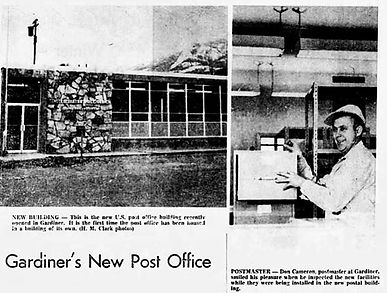
Gardiner Post Office
The post office was established in Gardiner on February 19, 1880. James McCartney becomes the first postmaster, serving until Sept. 17, 1883. By the early 1900s, the M.H. Link Post Office Store operated the PO. From 1936-1939, J.J. Moore’s store maintained the PO, and from 1939-1960, it was housed in the W.A. Hall store. In 1960, a new post office was completed on West Main St, the first time it had its own building. By 1998 the post office in the growing town had proved too small and a new facility was built on Hwy 89, near the new North Entrance Shopping Center.
[Photo, Great Falls Tribune, 21Feb1960]
Yellowstone Park Transportation Co moves in south of town . . . . .
With arrival of the Northern Pacific to Gardiner, YP Transportation Co. began creating storage facilities for the stagecoaches and horses, and bunkhouses for the stage drivers and related employees. These were created at the southeast of town along the Gardiner River around 1904-05. They were beautifully crafted stone and wood buildings utilizing designs by Robert Reamer. These included the large stable capable of housing 125 head of horses, and an open-sided carriage storage building featuring stone pillars. A duplex structure provided driver bunkhouse and mess facilities. When the transportation system was motorized in 1917, the former carriage house and stables were used for the White Motor Co. automobile fleet.
The Butte Daily Post remarked on May 9, 1906 that, “The Transportation company anticipates a large business. The company is erecting a mammoth barn at Gardiner. There are sixty men now employed on the structure, which will house many of the horses used by the company. The company has a great barn at Mammoth Hot Springs, from where all its passengers make the start throughout the park, but it was found desirable to have stables at Gardiner, where stages meet the trains.”
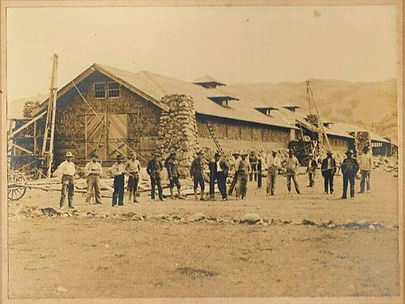
Top: Construction of the new horse barns in Gardiner in 1906. It was located in the area in front lf the current bunkhouse. [Photo author's digital collection]
Bottom: Horse Barns in Gardiner in 1915. The building has a remarkable resemblance to the current Xanterra Bunkhouse, located closer to the Gardiner River. This building would have been torn down around 1925 during construction of the new concrete auto storage building. No doubt parts of it were used for the bunkhouse. [Photo courtesy Rawhide Johnson]

Top: Stage driver's bunkhouse and mess in the foreground. The Carriage House is to its left. followed by the horse barn. 1917 photo by Jack Haynes. [YNP #199718-60]
Bottom: Close-up of driver's bunkhouse and mess in 1915. the building survives as an employee duplex for Xanterra Parks & Resorts. [Photo courtesy Rawhide Johnson]

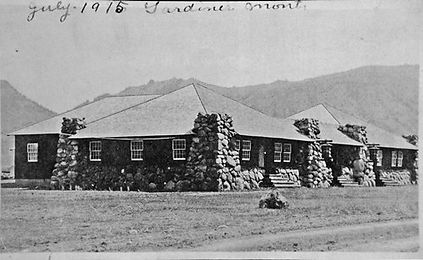
Fire at Mammoth and new modern transportation buildings in Gardiner . . .
On March 30, 1925, fire broke out in the YPTCo main bus barn at Mammoth, which had been built in 1903-04 and designed by Robert Reamer. Within an hour, the entire barn was a total loss. Included in the damage were the smoldering ruins of about 93 vehicles, including 22 7-passenger White touring cars, 53 10-passenger White buses, and 18 other vehicles. One of the employees described part of the inferno, “Explosion of the large number of presto-light tanks which are part of the equipment of the busses, provided one of the spectacular features of the fire, Mr. Frazer said. Exploding like giant firecrackers, some of the tanks shot into the air a distance of 100 feet, leaving a trail of fire in their wake.”
The opening of the summer season would arrive in a mere 2-1/2 months and the vehicles had to be replaced! Harry Child, head of the hotel and transportation companies, quickly got in touch with Walter White of the White Motor Company. Negotiations were soon finalized for the purchase of ninety model 15/45 buses, along with 9 service trucks. The White company scrambled together all their resources and was able to have the new vehicles arrive in time for the opening of the 1925 season.
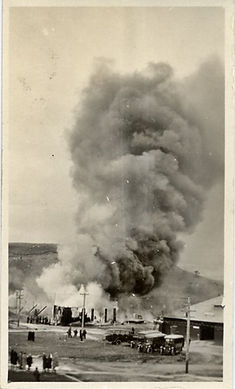
Photo of the tragic fire that destroyed the artistically-designed barn and garage at Mammoth in 1925.
[Photo courtesy Bill Chapman]
Coincidently, YPTCo had been constructing larger and more modern garage facilities in Gardiner. Although originally scheduled to open in the fall, this project too was rushed to completion in time for the June opening. This new facility included modern mechanics stalls, body and upholstery shops, carpenter shop, blacksmith shop, tire and battery shop, paint shop, and a coal-fired heating plant. The building is still in use and accommodates Xanterra Parks & Resorts Transportation facilities and Human Resource divisions. Around that time, a 2-story stone house was erected next to the driver’s bunkhouse, for the head of transportation, Fred Kammermeyer and his family, as their home had been destroyed in the fire.
Top: The transportation garage and shops completed in time for the 1925 season. 1927 view. [Montana Historical Society #H-26469]
Bottom: Concrete storage building for the vast auto fleet, also constructed in 1925. It replaced the artistically-designed barn and carriage shed. 1951 view.
[YNP #32072]
View of Park St. ca1905, from an original negative in the author's collection.
No Publication or reproduction without permission.
From Left to Right, there is the Park Hotel, the 2-story to the right is "General Merchandise." 2-story bldg in center is a Saloon, advertising Bozeman Beer, Toward the right is a 2-story false front OK Store - groceries, gen. merch. etc., and to its left is the M.H. Link Store. Eventually the Link family took over both buildings.
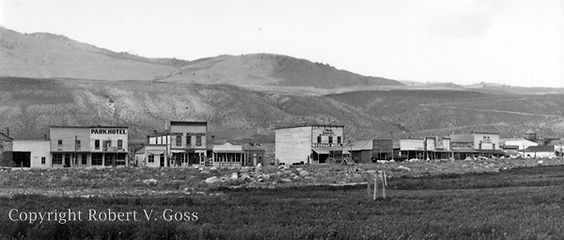
A Trip to Gardiner in 1915 by a pair of Texas Ladies . . .
Two young ladies from Denton, Texas describe the Northern Pacific Railroad Depot and Swinging Bridge in Gardiner when beginning a Yellowstone Park tour with the Shaw & Powell Camping Co. Misses Myrtle Cody, Writer of the Article, and Maida Edwards of Denton, were in the party which spent several days in Yellowstone Park"
“Tells of Scenic Beauties”
“We arrived in Gardiner, Montana, at 5:30 on June 25 [1915]. Gardiner is a typical Western village. It is all built on one side of the street at the north entrance of the Yellowstone Park. We step from out Pullman and we see a beautiful rustic depot built from unhewn pine logs and rough stones. It is a masterpiece of quaint architecture.
“The inside of the depot is just as attractive as the outside. The big fireplace in one end of the waiting room with a split log mantle catches our eye. You glance around the room and see on the mantels and walls only decorations of nature, such as pine burrs, curious-shaped pieces of wood, different kinds of stones from the park, and elk horns. At the other end of the room is the ladies’ rest room with all modern conveniences. We would like to rest here awhile, but a twelve passenger coach awaits us at the door, with six big white, impatient horses, ready to carry us to the Shaw & Powell hotel, where we are to spend the night.
“We are warmly greeted at the hotel and enjoy our stay overnight. The following morning we walk over the village, and one interesting place we visit is an extension bridge over the Gardiner river. It is built for pedestrians and is said to hold up to four people, but wait until you walk out to the center, where the bridge swings up and down with each step, while the rushing, foaming water beneath roars until you do not know whether you are going up or down; then you think it will not hold one. The coach leaves the hotel at 11:30 for first camp, which is Willow Park, and everyone is ready. The first and second coaches are full, but there is room in the third coach for our party and four more passengers.
Denton Record-Chronicle (Texas) Thursday, August 12, 1915
Park Street in the 1920s & 1930s
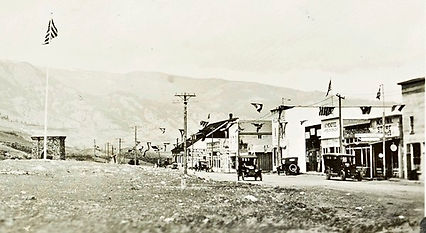
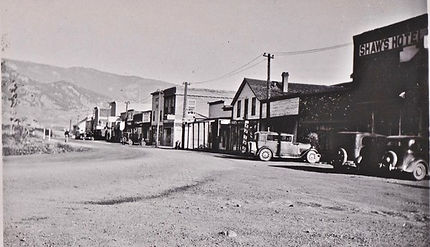

Top Left: Park St. in 1923. The store to the right in front of the old car, is the M.H. Link Store. Eventually the Link family owned the large bldg on the corner also, operating a grocery until 1966. To its left are two Menefee business, probably a saloon and billiards hall. Wm. Menefee drove stage in earlier days and later was a judge in Gardiner. [YNP #11347-7]
Top Right: Park St. in the 1930s. To the right is the Grotto Cafe, with a small Lantern Cafe sign lower down. The M.H Link store is to its left, The 2-story bldg down the street is the Welcome Hotel, with a saloon or beer hall to its right. The Park Hotel is the next 2-story, with the Moore Store a few doors down. The W.A. Hall store is at the end of the street. Original photo has been cropped for clarity. [YNP #11347-7a]
Bottom Left: Park St. in the 1930s, view from the east end of the street. The Shaw Hotel & Cafe to the right, The 2-story to its left was once the Gardiner Hotel, with what was C.B Scott's Saloon to its left. The Grotto Cafe and M.H. Link Store cab can be seen near the 3rd power pole. [Real-Photo postcard]
Below: Park St. in 1939. J.J. Moore's Store to the left, next to the Arch Cafe, the old Park Hotel to its right. The next 2-story is the Welcome Hotel & Cafe, The Ranger Tavern is 3 doors down, in front of the car. Two doors down is the M.H. Link store and then the Grotto Cafe, next to the State 'Theater?'. The Shaw Hotel & Cafe is toward the end of the street. Photo has been cropped for clarity. [YNP #185327-492]

Gardiner continues to grow in the 1920s and on . . . .
Hwy 89 was extended into Gardiner on the east side of the Yellowstone River in 1926 and the old original dirt road from Yankee Jim Canyon to Cinnabar and Gardiner that navigated along the west side of the river became a secondary road. A concrete bridge was built over the Yellowstone River at its present site in 1929, tying the two sides of town together, encouraging more growth on the north side of town. Tourist courts began to emerge with motels later following that trend. The face of businesses on Park St. seemed to change regularly over the years. Ownerships changed hands, buildings were remodeled and expanded. And of course, the old nemesis - ‘fire’ - took its toll over the years - the Moore Store on Park St. in 1916, The Wylie Hotel and other buildings on Main St. in 1935, the Shaw Hotel in 1950, and the North Entrance Shopping Center on Park St. in 1971. Moore moved his business next to the Wylie Hotel, fine residences replaced the Wylie Hotel, the shopping center rebuilt and reopened, and the Town Club & Café replacd the old Shaw Hotel. No doubt other buildings added to the carnage along the way. But the town continued to grow and thrive, if even only seasonally.
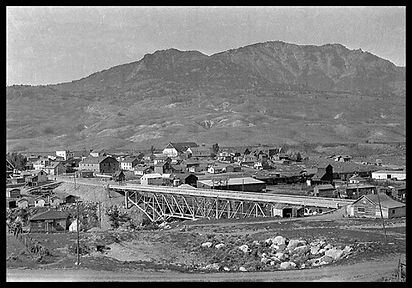
The new bridge over the Yellowstone River built in 1930. A community dance and picnic is held on the bridge to commemorate the opening.
[Photo courtesy Ron Nixon Collection, Montana State Univ.]
Early Hotels Serving the Needs of Tourist and Locals Alike

Gardiner Hotel in center, w/C.B. Scott's Saloon to its left, ca1900. [YNP #37094]
Gardiner Hotel
This was operated by W.A. Hall in at least 1892. Early Sanborn maps showed a Gardiner Hotel located on Park St., about where the Shaw & Powell hotel was located some years later. In 1892, Hall began a Golden Rule Cash Store in Cinnabar and by 1891 he was proprietor of the Cinnabar Hotel. Hall moved his merchandise operations to Gardiner in 1903. A.L Roseborough was listed as being in charge of the hotel in Nov, 1902. The Gardiner Hotel is a rather ambiguous name, and tracking its history is difficult at best.
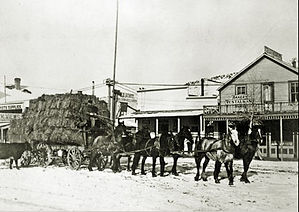
Gardiner Hotel at right, w/C.B. Scott's Saloon to its left, ca1900. The hay wagon was probably one owned by Scott with delivery to the Army at Mammoth.
[Univ. of Montana, Missoula, M81-0432]

Park Hotel to the left, and 2-story General Merchandise to its right, part of the bottom of which was the Tripp & Melloy Park Saloon, 1905 [Original negative in the author's collection.
No Publication or reproduction without permission.
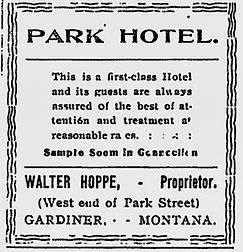
Ad for the Park Hotel and saloon, run by Walter Hoppe, son of Hugo Hoppe.
[30Apr1903, Gardiner Wonderland]
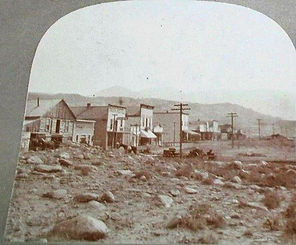
Park St. 1904, Park Hotel left of center, with General merchandise to its right. The other 2-story became the Welcome Hotel.
[Stereoview, no markings on front of card.]
Fitzgerald - Park Hotel
S.M. Fitzgerald, having served as an Ass’t Superintendent in Yellowstone, moved to Gardiner in Jan. 1886. On July 17, 1887, The Livingston Enterprise announced that Fitzgerald, “has nearly completed a large hotel in Gardiner. It apparently was one of the few buildings to survive the great fire of 1889. Known as the Park Hotel, WW Wylie leased it in 1897 for his camping operation. Walter Hoppe purchased it in 1902 and reopened the hotel. The Park Hotel is a rather ambiguous name, and tracking its history is difficult at best, with numerous Park Hotels in Montana, and that it is regularly confused in newspapers with Yellowstone Park hotels.
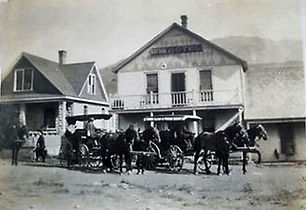
Cottage Hotel, early 1900s. The sign clearly reads Hotel, but the rest is unreadable.
[Real-Photo, author's digital collection]

Ad for the Dewing Hotel,
[18Apr1905, Gardiner Wonderland]

Cottage Hotel, early 1900s. The sign clearly reads Hotel, but the rest is unreadable.
[Yellowstone Gateway Museum, 2006-044-0168]
Dewing Hotel - Cottage Hotel - Gateway Hotel
Located on E. Main St, on the north side ( Lot 2, Block 11). Isaac D. McCutcheon, who platted the area, originally owned the property. Augustus T. French purchased the lot on 12/8/1890 from McCutcheon. It was sold to James McCartney the following year. The hotel was in existence by at least 1905 and run by John H. Dewing. At some time the wife of Jim ’One-Eyed’ Parker ran the hotel. John F. Curl and his wife Zona sold their properties in Cooke City and moved to Gardiner around 1915 and ran the Cottage Hotel. John died October 1, 1924. For a time it was operated by Bob & Anne (Sommerville) Jones, and became known as the Gateway Hotel by at least 1950. It is currently used as an apartment complex on Main Street.

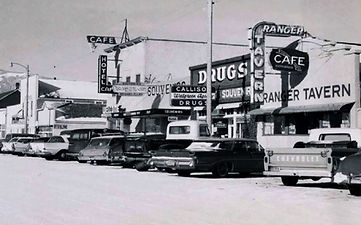
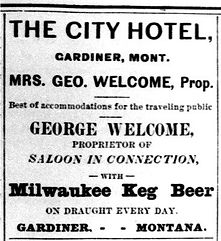
Welcome Hotel
George Welcome established the City Restaurant in Gardiner by 1885, and in early 1886 it was announced he was preparing to open a hotel in conjunction with the restaurant located on Park St. By June 1886 ads for the City Hotel were running in the Livingston Enterprise, with his wife as proprietor and George running the saloon. The hotel burned down in the great fire of 1889. After that, the family seems to have moved to Jardine and conducted businesses in that mining town. He was also at various times a businessman at Horr and Cooke City. At some point a new hotel and restaurant were built and by the mid-1920s, was operated by George Welcome, Jr. until sometime in the 1950s. George passed in 1958. A hotel continued to operate at that location at least into the 1970s.
Top Left: View of Park St. in 1939. The Welcome Hotel & Restaurant is the 2-story at the left. Photo cropped for clarity. [YNP #185327-492]
Top Right: Park St. in 1960. The Cafe and Hotel sign can be seen mid-left. The Ranger Tavern is at right, with Callison's Walgreen Drugs to its left and Yankee Jim's Souvenir and gift shop next to the Welcome. [YNP #28326-2]
Left: 1886 ad for George Welcome's City Hotel & Saloon. [12Jun1886, Livingston Enterprise]
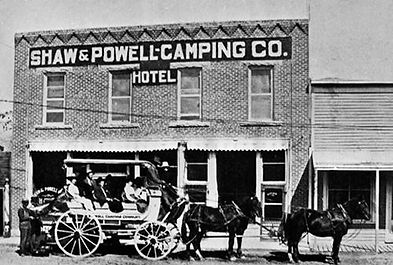

Top: Shaw & Powell Camping Co. Hotel, with guests ready for a 5-6 day tour of Yellowstone. [Yellowstone Gateway Museum #1317]
Bottom: Shaw's Hotel & Cafe, 1930s, looking rather rundown. [Author's digital collection]
Park St. in Gardiner, late 1940s. Note the Shaw Hotel & Cafe on right. Photo has been cropped for clarity. [YNP #33335]

Shaw & Powell Hotel - Shaw Hotel & Cafe
The Shaw & Powell Camping Co. initially brought guests into Yellowstone from the north entrance and in 1909 officially opened the Shaw & Powell Hotel in Gardiner to serve their guests before and after their arrival on the Northern Pacific train. They had been leasing the lot since 1907, and the Sanborn Insurance map of Gardiner in 1907 showed a "Gardiner Hotel" on the site at that time. The S&P Hotel may have been remodeled by the Shaw family for their hotel. Previously, the corner was occupied by C.B. Scott. In the early 1920s, the hotel name changed to the Shaw Hotel & Cafe, owned and operated by Walter Shaw and his wife from 1922-25, Walter also guided tours through the park to the Cooke City area where he operated Shaw’s Goose Lake Camp. Walter drowned in the Yellowstone River in 1925 and his family continued to operate the hotel until 1944. At that time it was sold to Hugh Crossen and J.D. Winters who operated it under the name Park Hotel and Café. They sold it to Paul Spradlin a few years later and in 1950 the hotel burned down, killing two persons. Crossen repurchased the property and built the Town Club & Café utilizing the original stone back and side walls. The property changed hands several times until 1969 when it passed into the hands of Don Laubach. The family still operates the business under the name Town Motel, Lounge, and Café sometime into the 2000s, when other parties took it over. It was torn down around 2019 by new owners..
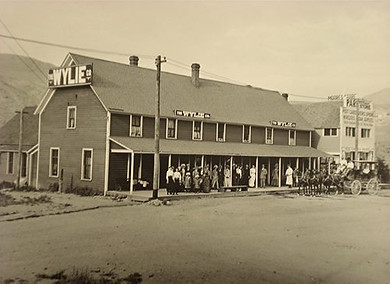
Wylie Hotel, ca1915. Next door is the Moore's Park Store, selling postcards, tourist curios, etc. [YNP #9555]
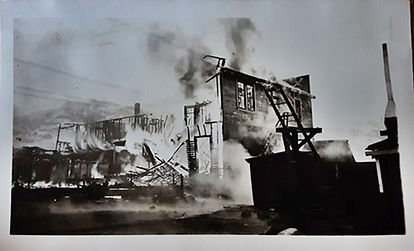
The tragic fire of Jan. 8, 1935. The Wylie Hotel is at the left, and the former Moore's Store at right.
[Photo courtesy Jeanie LaCombe Gregorich]

Wylie Hotel, Sept. 7, 1914. Note the changes made in first photo. To the left is the Community Church, completed in 1905. [Tourist photo album, author digital collection]]
Wylie Hotel
W.W. Wylie and his Wylie permanent Camps Co. originally leased the Park Hotel in 1897 from S.M. Fitzgerald for the use of his guest arriving and departing Gardiner. He apparently used this hotel for about 5-6 years. With the arrival of the railroad to Gardiner, Wylie decided to build a new hotel. Construction began in early May and no doubt opened in time for the new season. The Gardiner Wonderland noted in the spring that, “Wylie is building a barn on Stone St. in Gardiner, facing the RR tracks. Work on his new hotel is progressing rapidly. The Wylies had purchased lots on Main St. north of the WA Hall Store to build the hotel.” The hotel was located on West Main St. behind the A.W. Hall store, which also opened in 1903. In mid-July 1905, the Wonderland announced, “W.W. Wylie has commenced the erection of a large annex to the Wylie hotel which will consist of an office and about forty more sleeping rooms.”
After the season of 1905, Wylie sold his camping operation to A.W. Miles, who was secretly backed by Harry Child. Miles named the new company Wylie Permanent Camping Co. The Wylie Hotel continued to operate for another 25 years. In 1917 The Wylie and Shaw & Powell Camping Cos. were merged, and the new Yellowstone Park Camping Co. no doubt assumed ownership of the hotel. At some point the hotel also housed the Lark Lunch Room. Little is known of the details of the hotel in later years. Tragically, the hotel burned down on January 8, 1935.
Early Businesses in Gardiner Serving Tourists and Townsfolk
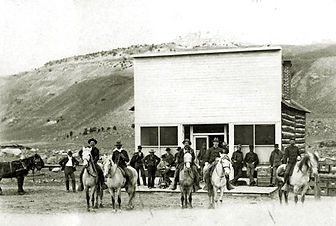


Early Saloons
Top Left: Larry Link Saloon, ca1890. It catered to locals and soldiers from the Park alike. It later became the Ranger Bar. It is located at the far left on photo top right. [CF Finn photo, YNP Archives]
Top Right: Park St. in 1890. The Ranger Tavern is at far left, CB SCott's Saloon & Billiards is at right on the corner. The Gardiner Hotel is to it right and Tripp & Melloy's Park Saloon was located right of the hotel (out of photo) Photo cropped for clarity. [YNP #33307]
Left: 1903 ad for Lawrence Link's Saloon and Club Rooms. [9Jul1903, Livingston Enterprise]
Right: Tripp & Melloy Park Saloon, ca1900, run by Dan Tripp and Jerry Melloy. It was later run by Harry Lloyd. George mack took over the business in 1910 and installed a barber chair. A wire screen was installed around the chair to keep drunks from falling into barber patrons. [YNP #37097]

Top: Tripp & Melloy Saloon with the Park Hotel at its left. Note the barber pole out front, this would date the photo to post-1910. There is a bath house between, probably in conjunction with the barber shop. The saloon continued to operate in a shared space.
Bottom Right: Ad for Park Saloon, Tripp & Melloy. [30Apr1903, Gardiner Wonderland]
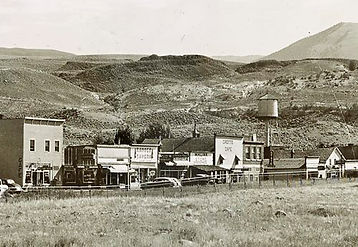
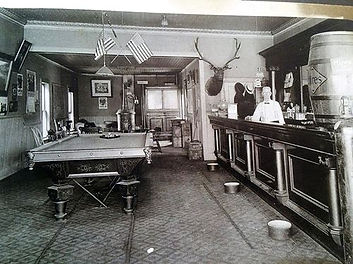
Ranger Tavern at Left
Top Left: Park St. 1939, showing Ranger Tavern, the 3rd bldg from left. The M.H. Link Store is two doors to its right. In the 1890s, the Ranger was oringinally known as the Link Saloon (See above). The Ranger Tavern re-opened after the repeal of prohibition by Roy ‘Two-Spot’ Brown. He built a house on the old Wylie Hotel site [YNP #185327-493]
Bottom Right: Interior of Ranger Tavern, undated. [Photo courtesy Dave Pompper]
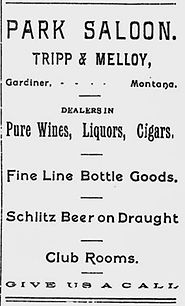


M.H. Link Post Office Store

Top Left: M.H. Link Post Office Store, ca1908.
Established by Mike H. Link in the early 1900’s, it was located on Park St., the 3rd store from the intersection with Hwy. 89. Otilla Link was postmaster from 1904 to 1908. By the early 1920’s it was known as the M.H. Link Store. Son Hubert later ran the business and expanded it greatly. He sold out to Gordon Evans in 1966. The Billings Gazette announced in June, “Councilman Gordon Evans [Livingston] has announced his resignation. Evans has purchased Link’s Shopping Center
in Gardiner and plans to move to Gardiner about the first of July. He also owns Evans Grocery in Livingston.” Evans operated the Gardiner store under the name of North Entrance Shopping Center. Mr. Evans passed away in Feb. 1971, and a mere two months later, the store, operated by his wife, burned down. The store was rebuilt and operated until 1994 when owners Deb & Larry Demaree, opened a new spacious store on Hwy 89 on the site of the Mountain View Motel.
Top Right: Interior of M.H. Link Store, 1900. Mike Link was the brother of businessman Larry Link. [YNP #37098]
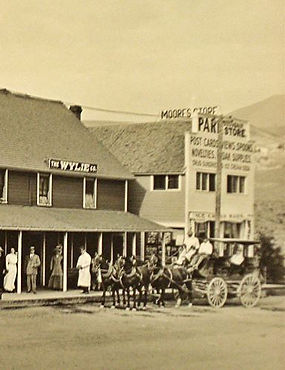
J.J. Moore Souvenir Store

Left: J.J. Moore's Souvenir Store, selling, postcards, Yellowstone views, park souvenirs & novelties. Next door is the Wylie Hotel. View ca1916. [YNP #9555]
Right: Moore's Park Souvenir Store, 1939, located on the west end of Park St. The W.A. Hall store would be toward its left. The Wylie Hotel burned in Jan. 1935, and Moore had moved his store sometime before that. Image cropped for clarity. [YNP #185327-493]
J.J. Moore seems to have started business in Gardiner around 1903 when he operated a jewelry store out of the new W.A. Hall store. By 1904 he advertised “Do you need anything in jewelry or silverware or a pair of new glasses?” He listed himself as a Jeweler and Optician in the ad. At some point in time he moved into his own store on Park Street that burned in 1916. Sometime after that he opened a souvenir shop in the old Park Hotel on Main Street. It was located east of the Wylie Hotel. During the 1914-16 seasons (at least) he was a stockholder in the Shaw & Powell Camping Co. By 1935 the Moore Store moved to Park St., near the W.A. Hall store and his old store was being used as a telephone office. Around that time the business was advertised as being in the Post Office Bldg. Sale items included: ice cream and soft drinks, candies, cigars, fishing tackle, Kodak supplies, views, guide books, park souvenirs, and groceries.
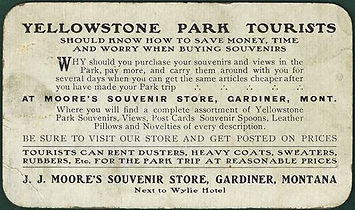
Advertising card from the J.J. Moore Souvenir Store.
Likely dated 1903-1916.
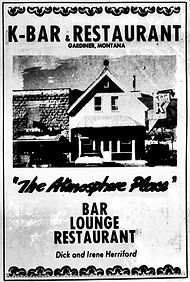
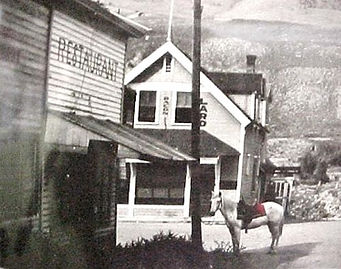
The Van Dyke & Deever meat market opened in 1895 at the corner of 2nd (Hwy89) and Main St. Van Dyck built the stone house across the street from the market for his residence in 1903. By the early 1900s the meat company was doing considerable business supplying beef and pork to the Army at Yellowstone, and by 1902, they were supplying all the park hotels and camps with meat. In May of 1919, Walter J. Hill, of Hill & McClelland Cattle Co., purchased all of L.H. Van Dyck’s holdings in Gardiner and Park County.
Van Dyck & Deever Meat Market
K-Bar Cafe & Club
From the Billings Gazette, April 1, 1972.

At least by the 1940s, the business was a bar and café. Jack Taylor purchased the K-bar in 1972 saying, “he bought a combination bar and restaurant last fall, hoping the legislature would authorize gambling as it had been authorized to do by the new constitution. “I’d be fooling if I said I didn’t speculate when I bought this . . I thought this was an ideal time to buy.” [Mt Standard, 27May1973]
The K-Bar was later purchased by Dick & Irene Herriford, who operated the bar and restaurant for 20 years before selling the business and building the Absaroka Lodge.
[Real-Photo postcard, author collection]
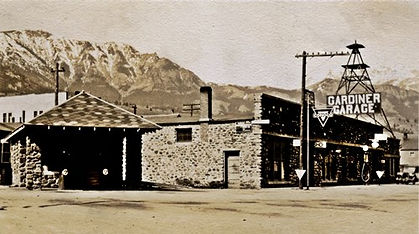
Holem & Pilger - Gardiner Garage
Frank Holem & Henry J. Pilger built a stone gas station on the corner of 2nd and Main St. around 1925 (across from the current K-Bar). They later greatly expanded the business. In May 1932, the business incorporated as Gardiner Garage Inc., of Gardiner, in Park county, with capital stock of $50,000. Directors were Frank and Minnie M. Holem and Henry J. and Elizabeth M. Pilger, all of Gardiner. Frank Holem had moved to Gardiner in 1893 as an itinerant blacksmith, gradually learning to repair automobiles as time went on.
[Photo cropped from company Christmas card, author's collection]
Grotto Cafe
Located on Park St., near the intersection of 2nd St. first opened in 1905. According to the Gardiner Wonderland in Aug 1905, "The Grotto Cafe recently opened to the public by C.W. Wardloe [Wardlow?], at the old Elk Restaurant stand, is doing nicely with the trade constantly increasing. Mr. Wardlow certainly runs a first-class house, has nothing but the best of cooks, and his tables are supplied with the best the market affords. He desires your patronage. When in town call on him and get a square meal."
The building continued to be viewed in photos next to the M.H. Link Store from the 1930-40s, but by sometime in the 1950s an empty lot began appearing. [Real-Photo postcard, cropped for clarity]

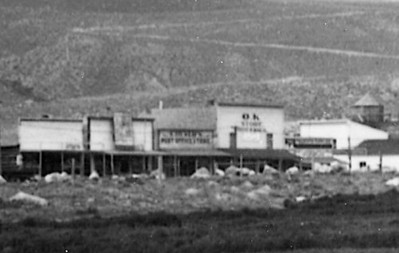
O.K. Cash Store
Located on the corner of Park St. and 2nd in 1900, it was operated by George (G.E.) and Mamie Settergren. Advertisements were common in the short-lived Gardiner Wonderland. Little else is known about the store. The O.K. Grocery Store was operated in the 1890's by Jos. Dailey, but unknown if same building.
Top Left: The OK Store, next to the M.H. Link store, ca1905. [Goss Negative]
Top Right: Ad for the O.K. Grocery Store, run by Jos. Dailey.
[Livingston Enterprise, 25Jan1890]
Right: Ad for G.E. Settergren's O.K. Cash Store. [Gardiner Wonderland, 26May1902]
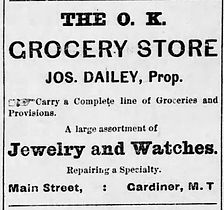
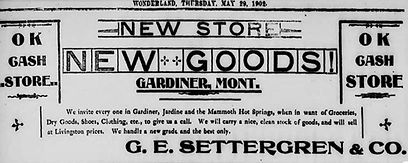
C.E. Wilcox Jewelry and Pictures
This store was located on Park St. between the Moore Store and Welcome Hotel, in the small building that was once the Deli. It was run by Clarence Eugene "Gene" Wilcox and his wife Gina, beginning around 1927. They sold jewelry, quartz and agates crafts. Gene also specialized in clock repair and published several wildlife postcards. He died in his store in early 1971, preceded by his wife in 1958. An auction for sale of the goods and equipment was held in June 1971.
Advertisement from the Gardiner-Gateway Gazette, 30 May 1940
W.A. Hall Store

Above: The W.A. Hall Store in the 1930s. Next to it is a gas station operated by the Hall Company, with the Roosevelt Arch to the left. Behind them on Main St., is the Wylie Hotel. [Cropped image from a W.A. Hall Christmas card, author's collection]
Bottom Left: Early image of the W.A. Hall Store on West Park St. Their claim to fame was that, "We Sell Everything."
[YNP #37081, ca1905]
Bottom Right: Undated early photo of the W.A. Hall Store. The window signs indicate a drug store at the right end of building. [Courtesy Yellowstone Gateway Museum]


W.A. Hall Store
William A. Hall built this store in Gardiner near the Arch and rail depot in 1903 and provided all of the basic necessities of life for the tourist, hunter, and resident. The large upstairs was home to many community dances in its heyday. The building was originally designed by architect Robert Reamer, but due to cost and time considerations, the building was modified to simplify and speed up construction. Hall originally ran stores in Cinnabar and Aldridge, but with the opening of the railroad to Gardiner, he started a new store here. The Cinnabar store closed right after his move and he left Aldridge after the coal strike of 1904-05. The store was a Golden Rule store, the forerunner of the J.C. Penny franchise. Hall later moved to Bozeman and his sons Earl, Warren, and James operated the store until 1955 and sold the building in 1961 to Cecil Paris. The building still stands and was home to a variety of businesses, including laundromat, bookstore, coffee shop, video store, TV cable service, and gift shop for many years. In 2008 the Yellowstone Association, the nonprofit education foundation that benefits the park is committed $4 million to buy the property and an adjoining lot and refurbish the 12,000-square-foot building to create its new headquarters. The association spent $2.9 million renovating the building and in April 2009 moved its headquarters from Mammoth to the new facility. The building now houses the offices, an educational store, a visitor information desk, two classrooms and a display on the building's history.
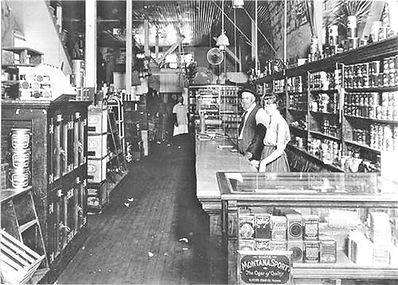
Undated photo of the interior of the W.A. Hall Store. [Courtesy Yellowstone Association]

W.A. Hall Conoco Service Station, ca1920s. [Courtesy Yellowstone Gateway Museum]
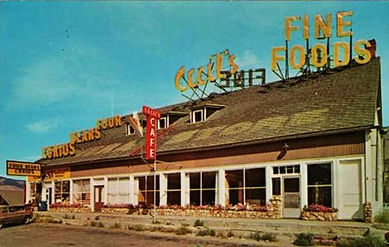
W.A. Hall Store after it became Cecil's Fine Foods. The Four Bears Curio shop was located at the left end. The large neon signs on the roof lit up that end of town for many a year. [Real-Photo postcards, 1960s]
W.S. & A.F. Berry Photographic Studio

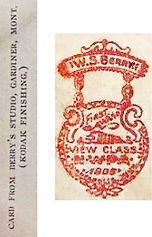
Above: Deck of Wildflower Post Cards. Published By W.S. & A.F. Berry. Set of 12 Each Measured 5.5" x 3.5" with divided backs. The set of cards were "Made in Germany" and dated 1905. Flowers Include: Harebell, Gentian, Mentzelia, Wild Rose, Monkshood, Lupine, Bitter-Root, Flax, Larkspur, Iris, Indian Paint Brush, and Columbine
Above Left: Typical postcard trademarks. The earlier cards used the Red Emblem, front & back, while later cards simply had the credit line on the reverse.
William Sanford Berry was born December 1866 in Indiana and passed away December 1948 in Pomona, Calif.
Aurinda "Aurie" Sophronia Ferris Berry was born Jun 1872 in Illinois, and passed on October 1950 in Pomona, Calif.
The Berry family moved into Gardiner in 1902 and established a photo studio in a tent at the north end of town. According to Ruth Quinn, the couple purchased two lots on Main St. in 1911 and had a new building constructed called the Gardiner Studio.. The husband and wife team produced at least 60 known postcards of the Yellowstone area. Many of them featured beautiful fauna and flora depictions, while stagecoaches were featured in several others. Documentary-type photos were also taken in nearby communities. Larger format photos were vailable, 4x5", 5x7" & 8x10", in either glossy or dull finishes. During the sixteen years they spent in Gardiner, one or both of them established temporary studios in other Montana towns to supplement their income.
A son was born in 1912 - Ferris Milton Berry, who spent most of his career in the Air Force. The family moved out of Gardiner in 1918 and according to Find-a-Grave.com, W.S. served as "warden of Sully's Hill Game Preserve at Fort Totten ND; the preserve being established by President Teddy Roosevelt to help rebuild the herds of elk, deer, and bison which had been over hunted nearly to extinction. After several Dakota winters, William decided there was too much pioneering at Fort Totten for a man his age and in 1920 moved his family to sunny Long Beach CA; and in 1926 relocated to Pomona." They passed away in 1948 & 1950 respectively and were buried in the local cemetery. Unfortunately no photos have yet been located of their studio or of themselves.
Tourist Camps & Motels Begin to Replace Hotels in the 1920s - 1960s

Reifsteck Cabins
These were run by Mrs. Viola Reifsteck, perhaps beginning in the late 1920s. According to the Billings Gazette in 1966, "Mrs. Viola Reifsteck, 79, of Gardiner died Tuesday in a Livingston hospital She was born Oct 27, 1886 at e Perry, Iowa. She came to Gardiner in the early 1920's and then operated a tourist court for many years. Her husband, Phillip F., preceded her in death in 1943. Surviving are a son, Lewis, of Gardiner, one grandson and several brothers and sisters."

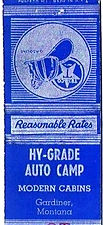
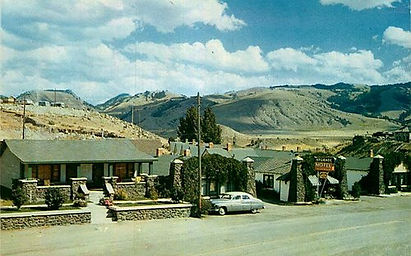

Hy-Grade Cabins - Hy-Grade Auto Court - Hygrade Motel
The Hy-Grade Auto Court Co. was founded in May 1931 by Ed Travaskis, D.T. White, and Lawrence McmAhon. Deade White owned and operated the Hy-Grade Motel in Gardener from 1935 until 1964, possibly with Travaskis for a few years. In 1965, the Montana Standard-Post reported the, “HyGrade Motel at Gardiner has been purchased by Levi Haynes of Gardiner and Ray Yardley Jr. of Livingston, from owner Vaughn Kearns. The new owners said the motel will be closed during the winter months. The North Gate Texaco gas station was added in 1948 and operated under a lease to other persons. When Hwy 89 was widened and improved through Gardiner in the early 1970s, the portion of land upon which the gas station was located, was condemned by the state highway dept for the right-of-way. In 1990, the Absaroka Lodge, owned by Dick & Irene Herriford, replaced the old cabin units with new multi-story guest rooms, retaining the unique stone pillars at the entry way to greet motel visitors.
Left: Hy Grade Auto Court & Texaco Station. Postcard ca1950s.
Center: Matchbook from the Hy-Grade Auto Court
Right: Hygrade Motel, early 1970s. Hwy 89 had been widened and Texaco Station removed.
Left: Current photo of Absaroka Lodge, with historic stone pillars.

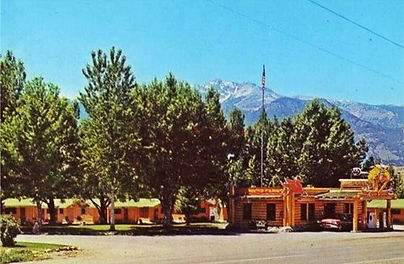

Jim Bridger Log Cabins
Located at the north end of town on Hwy. 89, George A. Larkin was noted as proprietor of the cabins in March 1940 (The Missoulian). The same newspaper mentioned David Fraker as owner of the Jim Bridger Motel Court in Dec. 1972. Another paper called it the Jim Bridger Motor Court in 2016. Jim Kemp built the Best Western motel next door and took possession of the Cabins. The central office building was moved in 1991 to make way for the new First Interstate Bank building. In 2019 Delaware North bought out the Best Western Motel, Rusty Rail Restaurant & Saloon, and the Jim Bridger Cabins. The cabins were moved from the premises in 2020 under new owners.
Top Left: Jim Bridger Log Cabins, Real-Photo postcard, ca1940s, probably soon after construction. Note the complete lack of vegetation on site.
Top Right: Jim Bridger Log Cabins, ca1950s. Real-Photo postcard.
Left: Jim Bridger Auto Court, ca1960s postcard.
Mountain View Motel
In 1940, the Mountain View Cabins were run by Lester J. Spangelo. Morris & Ida Demaree purchased and operated the motel in 1975 until May 1984 when they retired. Many of the units were torn down when the new Gardiner grocery store was built around that time. Larry & Debra Demaree, relatives of the couple, owned and operated the grocery store for many years and it is still in the family. Postcard ca1960s.
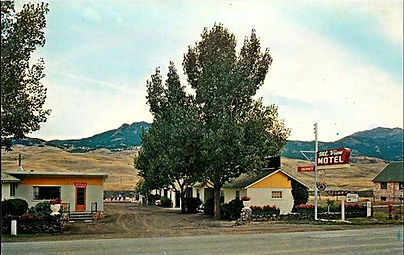

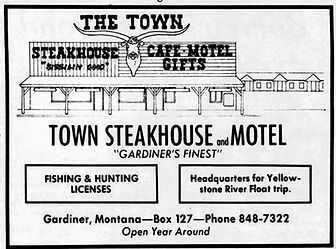
The Town Motel and Café
The Town Cafe sat on the site of the old Shaw & Powell Hotel, dating from the early 1900s. The Shaw family continued to operate the hotel until 1944, when it was sold to Hugh Crossen and J.D. Winters who operated it under the name Park Hotel and Café. They sold it to Paul Spradlin a few years later and in 1950 the hotel burned down, killing two persons. Crossen repurchased the property and built the Town Club & Café utilizing the original stone back and side walls. The motel was built a few years later. The property changed hands several times until 1969 when it passed into the hands of Don Laubach. The family still operates the business under the name Town Motel, Lounge, and Café sometime into the 2000s. Sadly, it was torn down around 2019 by new owners, including the historic stone wall remnants.
Left: 1960s postcard view of the Town Cafe & Motel. Right: Town Steakhouse and Motel ad, 1Apr1972, Billings Gazette
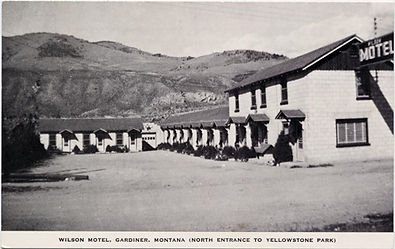

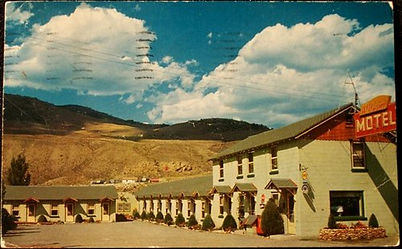
Wilson Motel - Yellowstone River Motel
The Wilson Motel began around 1947 by LeRoy & Agnes Wilson on the east end of Park St. They operated it until 1970 when they retired to Bozeman, Mont., and Sun City Ariz. At that time Paul Deweese took over the motel and operated until his death in 1989. His family has continued to run the motel since that time, changing the name to Yellowstone River Motel at some point.
Top Left: The Wilson Motel, postcard ca1950s.
Right: Wilson Motel postcard, ca1960s
Left: Yellowstone River Motel, current photo.

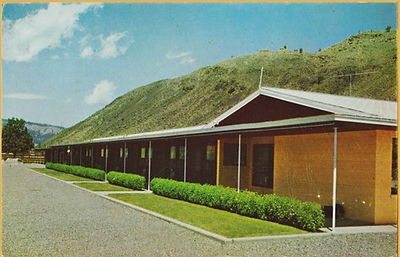
Westernaire Motel
Located toward the north side of town, on the east side of Hwy 89, it was owned by Dick & Irene Herriford, owners of the Absaroka Lodge. The motel has been torn down in the past 4-5 years and has been replaced by the Yellowstone Big Rock Inn, also under the auspices of the Absaroka Lodge.
Postcards ca1960-70s
Change is inevitable. Change is constant.
Benjamin Disraeli
The End of Rail Service to the Gateway of Wonderland . . . .
Scheduled passenger rail service to Gardiner ended in 1948, although freight service, along with an occasional special tourist train continued until 1954-55. Three trainloads of Girls Scouts brought in at the end of Aug. 1955 were reportedly the last train passengers to arrive in Gardiner. Political wrangling caused the beautiful NP depot to be demolished in 1954 by the backward-thinking Park authorities at the time, and another beautiful historic building was lost to history. It was replaced with a rather mundane-looking building that currently houses the public library, Sheriff’s Office, and Water Dept. A small public park occupies the former pond are and a beautiful log shelter with picnic tables has recently been added. The former railroad lands were eventually offered up for sale and a new public school was built on a portion of that land in 1951. Much of the school burned down in November of 1985 and was rebuilt in the ensuing years.
The Changing Face of Progress . . . .
A boom in the late 1980’s and through the early 2000’s saw much new construction along the Hwy89 section of town. The grocery store moved from Park St. to Hwy 89 on the north side of town and a new Post Office was erected nearby in the past decade. New hotels inundated the town for a period of years, including a Best Western, Comfort Inn, and Super 8, Yellowstone Village Inn & Suites, Absaroka Lodge (Hygrade Site), Yellowstone Park Travel Lodge, Yellowstone Gateway Inn, Yellowstone River Inn (Wilson Motel), and others in the late-2010s. Most of the older-style mom & pop motels from the 1940-50’s era were either shut down or forced to upgrade to compete with the big chain hotels.
Park St. in the 1950s & 1960s - Postcard Views

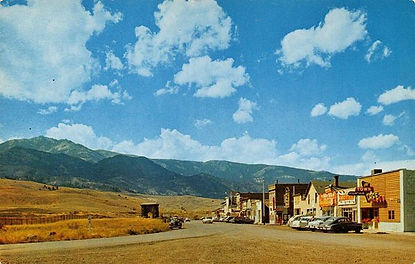
Real-Photo postcard, ca late-1940s at left. Notice the empty lot between the 2-story and M.H. Link store, where the Grotto Cafe formerly stood. The postcard on the right, ca1950s, the Town Cafe, with the Town Club occupying the old C.B. Scott bldg on the corner.

1950s postcard at left looking toward the East at dusk. The Welcome Cafe is still at the left, with Yankee Jim's to it right, followed by the Ranger Tavern, the Blue Goose and the Link Store.
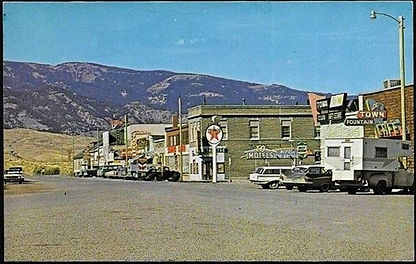
1960s postcard at right looking toward the West. The old C.B. Scott building has been replaced by a Texaco gas station. To the left, the Link Store has expanded into the formerly empty lot.
The 21st Century Come to Town . . . .
The recent trend of converting apartments to vacation rentals has stricken seasonal and permanent renters alike in this land-locked town that has never had adequate rental housing. The town continues to thrive, although changes and uncertainly in the snowmobile policies of Yellowstone Park have lessened that business considerably over the years. And despite the concerns of the anti-wolf crowd, the area continues to attract many hunters in the fall and winter due to the thousands of elk that migrate out of the park into the surrounding Forest Service lands. The wolves, hated by some and adored by others have created their own cottage industry of avid wolf-watchers. In recent years the white-water rafting business has burgeoned and supports at least five businesses catering to this adventure crowd. Hopefully this rampant commercialism will not drive away the very people required to maintain this huge service industry due to lack of affordable housing, as had happened in all too many other resort towns throughout the West. The changes wrought in this small town during the past 30 years have been significant, and the face of the town has been transformed. It is not the intention to delve into this ‘modern’ history. The author will leave that to a future history junkie.
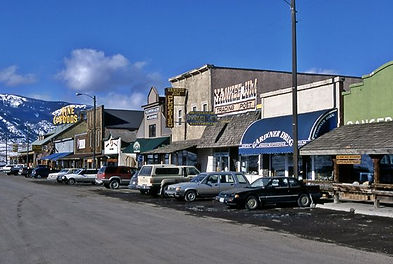

From Left to Right: Park St. 1999, by Jim Peaco, NPS; 2009; and a 2010s Google Earth Street View.









